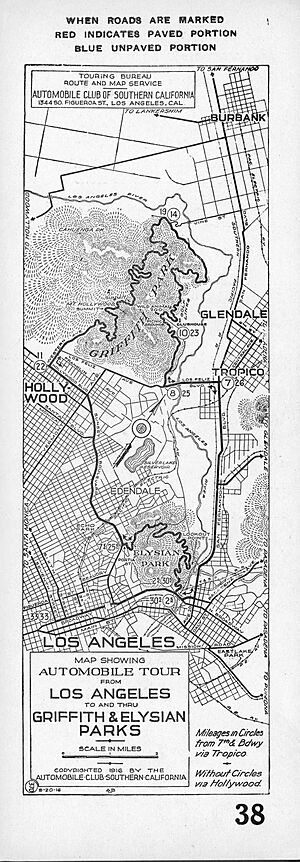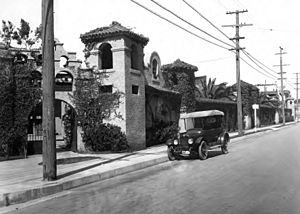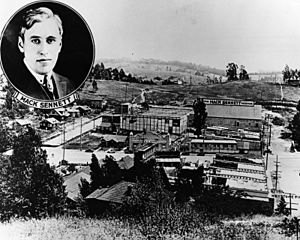Edendale, Los Angeles facts for kids
Edendale was a special area in Los Angeles, California, a long time ago. It was northwest of Downtown Los Angeles. Today, this area is part of neighborhoods like Echo Park, Los Feliz, and Silver Lake.
In the early 1900s, when movies were silent and didn't have sound, Edendale was super famous. It was home to most of the big movie studios on the West Coast. Many exciting things happened here for the first time! For example, the funny Keystone Cops were created here. Also, Charlie Chaplin made his very first movie in Edendale. The first full-length comedy movie was made here too. And guess what? The first ever "pie-in-the-face" comedy stunt happened in Edendale!
Most of these movie studios were on a street called Allesandro Street. This street is now called Glendale Boulevard. Edendale had lots of hills and a nearby lake. These features were perfect for all the silly stunts and chases in silent movies. The area was the center of the movie world in the 1910s. But by the 1920s, many studios moved to Hollywood. Hollywood then became known as the "movie capital of the world."
Before World War II, Edendale was also a home for many artists. It also had a large community of people who came from the Eastern United States or the Soviet Union.
People knew the name Edendale until about 1940. The Pacific Electric Railway even had a train line called the Edendale Line. These "red cars" traveled about 5 miles (8 km) between Downtown Los Angeles and Edendale. The train tracks ran down the middle of Allesandro Avenue (Glendale Blvd.). After 1940, the Edendale Line stopped. The train service ended completely in 1955. Soon after, a big road called the Glendale Freeway was built, which cut through the area.
Today, the name Edendale is not used much for the area itself. Most people don't know it. But you can still find the name in a few places. There's a local post office called Edendale Station. There's also a public library branch, a farm called Edendale Farm, and a restaurant called Edendale. Many old buildings from the 1910s are still there. But today, the area is mostly a busy commercial zone. It's known as the "Glendale Boulevard Corridor." It's mostly a road for people driving between the Glendale Freeway and downtown Los Angeles.
Contents
Edendale: The Early Movie Capital
In July 1911, a movie magazine called "Motography" wrote about Edendale. It said Edendale was a "very beautiful suburb of Los Angeles." It also called it "the motion picture center of the Pacific Coast." The magazine praised the clear air and sunshine, which were perfect for making movies. It also mentioned the amazing views from Edendale. You could see the Pacific Ocean, mountains, and tropical plants. It seemed like nature had set up the perfect scenes for movie cameras!
Selig-Polyscope Studio
In 1909, the Selig-Polyscope Company built the first permanent movie studio in Los Angeles. It was in Edendale, at the corner of Clifford and Allesandro streets. Colonel William Selig started the company in Chicago. His partner, Francis Boggs, set up the Los Angeles studio. In a few years, Selig moved most of his movie making to Los Angeles. The famous cowboy movie star Tom Mix made his first movies at this Edendale studio.
The studio was finished in 1910. Its front entrance looked like the bells at Mission San Gabriel. This mission-style look became popular. Other studios in Edendale copied this style.
In 1913, Selig bought more land in Lincoln Heights. He started moving his operations there. By 1917, he rented his Edendale studio to William Fox.
Bison Studio
After Selig-Polyscope, the New York Motion Picture Company came to Edendale in 1909. They mostly made short western movies called "one-reelers" under the name Bison Pictures. Their first studio was at 1719 Allesandro Street. It was just a small house and a barn.
At first, Fred J. Balshofer managed the studio. A few years later, the movie maker Thomas H. Ince took over. Ince only made a few short movies at the Edendale studio. Soon after coming to California, Ince leased a huge area of land (18,000 acres) in Santa Ynez Canyon. He moved Bison Pictures there. This new place later became known as "Inceville."
Universal Studio's Early Days in Edendale
On June 8, 1912, the New York Motion Picture Company joined with the Universal Film Company. The New York Motion Picture Company gave all its properties to the new Universal Film Company. They also agreed to release their Bison 101 films through Universal. Charles O. Baumann was the first president of the Universal Film Manufacturing Company. But he was soon replaced by Carl Laemmle.
In 1912, the Universal Film Manufacturing Company started its first studio in Edendale. It was called the Universal Edendale plant. After some legal issues, the Universal/Bison Plant was returned to the New York Motion Picture Company.
In late 1912, the Edendale lot that Bison used was bought by Mack Sennett.
Mack Sennett and Keystone Studios
After a difficult start, movie maker Mack Sennett and his Keystone Comedies came to Edendale in September 1912. They took over the studio lot that Bison Pictures had left. When he started, the lot was old and mostly empty. But soon, he became very successful! Within a few years, he owned 5 acres (20,000 m²) on both sides of the street.
Between 1913 and 1917, comedy meant Keystone. Mack Sennett was the first important person to make fast-paced, silly, and exaggerated comedies. He once told someone, "You had to understand comic motion." Then, he pushed the person into a swimming pool! "That is comic motion," he said.
Sennett was famous for his Keystone Cops. These clumsy police officers caused chaos all around Echo Park. He also had his Sennett Bathing Beauties, who included famous actresses like Gloria Swanson and Carole Lombard. Fatty Arbuckle made many movies at Keystone. And Charlie Chaplin was discovered there! Sennett's great female star was Mabel Normand, who was also his girlfriend sometimes. She even inspired a musical called Mack & Mabel.
Another cool thing at Keystone Studios was the "cyclorama." This was a huge rotating cylinder with a painted background scene. Actors would run in place, and the cylinder would spin. This made it look like they were moving across the landscape!
Fox Studios
By 1916, Selig had moved his studio. He rented his first Edendale studio lot to film director William Fox. At the Edendale studios, Fox made movies with stars like Theda Bara (including Cleopatra) and Tom Mix. Fox's success grew quickly. The studio lot was about 0.75 acres (3,000 m²). Within a year, he opened Fox Studios on a much bigger 15-acre (61,000 m²) lot in Hollywood.
After Fox left Edendale, the old Selig-Polyscope lot was used by several other studios. These included Clara Kimball Young and Garson Studios (in 1920), and Marshall Neilan Studios (in 1925). Within a year, the site was torn down. Today, a large apartment complex stands there. A historical plaque was put there in 1954 to remember Mack Sennett. But the plaque was removed in 2007 when a building was torn down.
Mixville
Tom Mix was a very popular star in early western films. He was known for his trick riding, stunts, and fancy clothes. He started his career with Selig-Polyscope. Then, William Fox took him over in 1917. Later, he joined FBO (which became RKO) in 1928. He also made "talkies" (movies with sound) with Universal in the 1930s.
Tom Mix managed his own films under Fox. He bought a 4-acre (16,000 m²) piece of land just north of Edendale's main street. He built a western movie set there that became known as Mixville.
Tom Mix's first horse, Old Blue, was buried on this land. Today, this area has banks and shops. It's a regular commercial strip at the corner of Glendale Blvd and Silver Lake Blvd.
Norbig Film Company
At 1745 Allesandro Street, between the Selig and Sennett studios, another studio was set up. This was the Norbig Film Company, which operated from 1914 to 1919. Norbig was a rental studio. It helped many new directors and producers get started. Today, we might call this an "incubator" for new businesses.
Director Hal Roach worked here. He made films starring Harold Lloyd as "Lonesome Luke." Hal Roach became very famous later with his "Our Gang" / "Little Rascals" series. He built his own studio in Culver City. Charlie Chaplin also worked here for a short time before starting his own studio in Hollywood. Other studios that used this space included French & Forman, Bronx, Reaguer Productions, Western Arts, Westwood Productions, and Harry Keaton.
Pathé West Coast
The Pathé West Coast Film Company had offices at 1807 Allesandro. But it's not known if they actually made any films there.
Edendale Community
From November 1914 to June 1916, Edendale was also home to a special community. This was the Edendale commune. It was started by a group of Mexican people who believed in sharing everything and living freely. They were part of the Partido Liberal Mexicano (PLM).
After being released from prison in 1914, Ricardo Flores Magon and his wife, Maria Talavera, along with other PLM members and their families, settled in Edendale. They rented five acres of farmland near 2325 Ivanhoe Ave in Silver Lake. Other members of the PLM also moved nearby. Later, other people who believed in similar ideas joined them.
These PLM members lived the shared life they dreamed of for the world. They grew fruits, vegetables, and raised chickens at Edendale. They sold these goods on the streets of Los Angeles and at the Plaza Olvera's open market. With the money they earned from farming, they bought things they needed. This included supplies to keep publishing Regeneracion, which was their newspaper.
|
See also
 In Spanish: Edendale (Los Ángeles) para niños
In Spanish: Edendale (Los Ángeles) para niños





